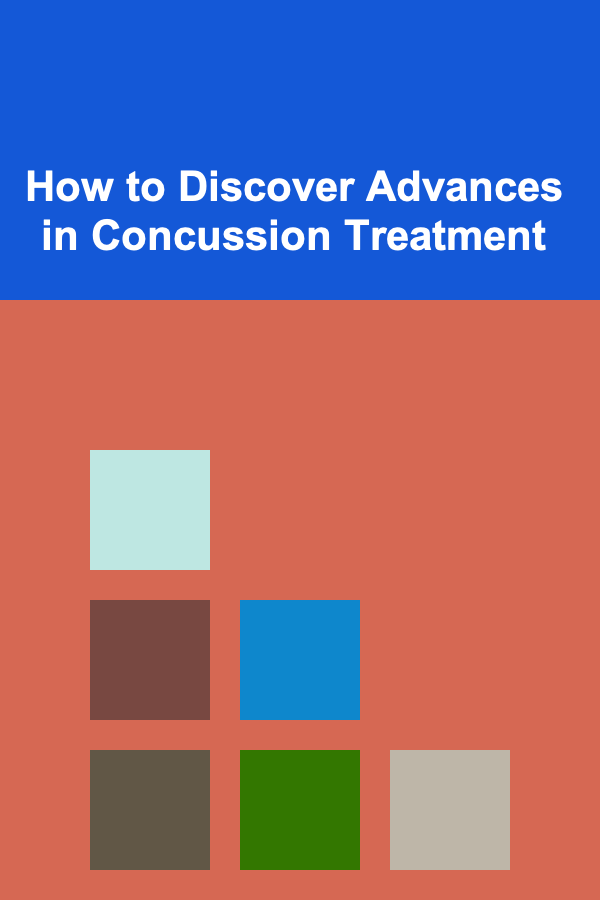
How to Discover Advances in Concussion Treatment
ebook include PDF & Audio bundle (Micro Guide)
$12.99$7.99
Limited Time Offer! Order within the next:

Concussions, a type of traumatic brain injury (TBI), are typically caused by a blow or jolt to the head or body. These injuries can range from mild to severe, and the treatment for concussions has evolved significantly over the years. However, despite increased awareness, there remains much to discover regarding effective treatments. As new research technologies emerge and more data becomes available, it's crucial to understand how to uncover advances in concussion treatment. This article will explore the key methods through which advances in concussion treatment can be discovered and implemented, with a focus on research methodologies, technological innovations, clinical trials, and multidisciplinary collaborations.
The Importance of Concussion Treatment
Before diving into how advances in treatment can be discovered, it's essential to recognize why concussion treatment is critical. A concussion, although often considered a mild brain injury, can have long-term effects if not properly treated. Concussions can lead to symptoms like headaches, dizziness, nausea, confusion, memory loss, and in severe cases, lasting cognitive deficits and emotional disturbances. Repeated concussions or inadequate recovery time can lead to more serious conditions like Chronic Traumatic Encephalopathy (CTE), a neurodegenerative disease.
Thus, timely and effective treatment is essential not only to mitigate immediate symptoms but also to prevent long-term health complications. This underscores the importance of discovering new ways to treat and manage concussions more effectively.
Advancements in Diagnostic Tools
The discovery of new treatments begins with accurate diagnosis. In the past, concussions were often underdiagnosed or misdiagnosed due to the absence of objective diagnostic tools. However, advances in neuroimaging, biomarkers, and computerized testing have made it possible to detect concussions more accurately, which is essential in discovering better treatments.
Neuroimaging Techniques
Traditional methods of diagnosing concussions relied heavily on subjective reports from the patient, along with physical and cognitive assessments. However, the development of advanced neuroimaging techniques like functional MRI (fMRI), diffusion tensor imaging (DTI), and Positron Emission Tomography (PET) has made it possible to visualize brain activity and identify structural changes resulting from a concussion. These imaging tools allow clinicians to observe the physiological effects of the injury, thereby improving diagnostic accuracy.
For example, fMRI allows for the mapping of brain activity and the identification of regions that are affected by trauma. PET scans, on the other hand, can detect changes in metabolism within the brain. By using these advanced imaging techniques, clinicians can more effectively monitor the progression of concussion and assess the effectiveness of treatment methods.
Biomarkers
Biomarkers, substances found in bodily fluids like blood or saliva, are another breakthrough in concussion diagnosis. Elevated levels of certain biomarkers can indicate brain injury. Research in this field has led to the identification of specific biomarkers that correlate with the presence and severity of a concussion. For instance, proteins like S100B and GFAP have shown promise as biomarkers for TBI. The development of rapid, non-invasive tests that measure these biomarkers could become a game-changer in diagnosing concussions, enabling clinicians to make quicker and more accurate decisions.
Computerized Testing
Computerized neurocognitive testing has become a staple in concussion diagnosis. Tests like ImPACT (Immediate Post-Concussion Assessment and Cognitive Testing) measure cognitive functions such as memory, reaction time, and attention. While these tests are useful, advances in artificial intelligence (AI) and machine learning are now enabling more sophisticated assessments. AI algorithms can analyze large datasets of concussion-related cognitive patterns, identifying trends and predicting recovery times more accurately. These advancements in diagnostic technology are crucial for shaping the future of concussion treatment.
The Role of Clinical Trials in Discovering New Treatments
Clinical trials have historically been the most reliable way of discovering effective treatments for medical conditions, including concussions. These trials involve testing new treatments on patients to determine their safety and efficacy. Advances in concussion treatment can be discovered through carefully conducted clinical trials, which allow for rigorous testing of drugs, rehabilitation protocols, and other therapies.
Drug Development and Pharmacological Advances
In recent years, pharmaceutical companies and research institutions have increasingly focused on developing medications to treat concussions. Current treatments primarily involve managing symptoms, such as pain relief for headaches or anti-nausea medications, but there are ongoing efforts to discover drugs that can address the underlying brain injury.
One avenue of research involves neuroprotective drugs. These are substances that protect brain cells from damage after a concussion. Some experimental drugs aim to reduce inflammation, which is thought to play a significant role in the progression of concussion symptoms. Others focus on enhancing neurogenesis, the process of generating new neurons to repair damaged brain tissue. The development of these drugs is a major area of focus in concussion treatment research, and ongoing clinical trials will play a critical role in determining their effectiveness.
Additionally, the use of drugs to manage the long-term effects of concussions, such as post-concussion syndrome or CTE, is an emerging field. Clinical trials exploring the potential benefits of certain medications, such as selective serotonin reuptake inhibitors (SSRIs) for managing mood disorders or anti-inflammatory drugs to reduce chronic brain inflammation, will help determine whether these approaches can offer long-term relief.
Rehabilitation Protocols
Concussion treatment has traditionally focused on rest and gradual return-to-play protocols, particularly in athletes. However, recent research is exploring more structured rehabilitation approaches to enhance recovery and reduce the likelihood of long-term symptoms.
For example, physical therapy is now being integrated into concussion treatment protocols. Specialized therapists can design exercises to help patients regain balance, improve coordination, and strengthen neck muscles, which may help alleviate concussion-related symptoms. Vestibular therapy, which addresses balance and dizziness issues, has also shown promise as a treatment for concussion-related vestibular dysfunction.
In addition, cognitive rehabilitation is becoming an essential component of concussion recovery. Cognitive therapy involves exercises designed to improve memory, attention, and executive function, which are often impaired after a concussion. As more clinical trials are conducted, the role of rehabilitation in concussion recovery is likely to expand.
Personalized Medicine and Treatment Plans
An exciting development in concussion treatment is the rise of personalized medicine, where treatments are tailored to individual patients based on their unique needs and biology. Genetic testing, neuroimaging, and cognitive assessments allow clinicians to create more individualized treatment plans for concussion patients.
For example, some people may be more susceptible to severe symptoms or long-term complications due to their genetic makeup. Others may have pre-existing conditions that influence their recovery. By understanding these factors, clinicians can design treatments that are better suited to each patient, leading to faster and more effective recovery. Personalized medicine also opens the door to the development of new drugs that target specific pathways in the brain.
Technological Innovations in Concussion Monitoring and Treatment
Technological advancements are playing an increasingly important role in improving concussion treatment. Wearable devices, virtual reality (VR) technology, and artificial intelligence are all contributing to better monitoring, diagnosis, and treatment of concussions.
Wearable Devices for Concussion Monitoring
Wearable technology is increasingly being used to monitor concussions, particularly in athletes. Devices like the X2 Biosystems Head Impact Monitor and the Catapult Sports concussion detection system measure impacts to the head during physical activity. These devices use sensors to detect the severity and frequency of impacts, providing valuable data to trainers, doctors, and coaches about when a concussion may have occurred.
Some of these devices even use real-time data to track recovery, enabling clinicians to monitor progress and make adjustments to treatment plans. These advancements are particularly important for preventing repeated concussions, as they allow for more precise monitoring of the injury and recovery process.
Virtual Reality and Rehabilitation
Virtual reality (VR) is emerging as a promising tool for concussion rehabilitation. VR can be used to simulate environments where patients can practice cognitive and physical exercises in a controlled, engaging setting. For example, VR systems have been used to help patients with balance issues practice navigating various obstacles or scenarios. The immersive nature of VR allows patients to re-train their brains in ways that traditional therapies cannot.
VR has also been used to address the psychological aspects of concussion recovery. Many concussion patients experience anxiety, depression, or post-traumatic stress disorder (PTSD). VR therapy can simulate situations where patients gradually confront and manage these feelings, offering a unique form of treatment that can complement traditional methods.
Artificial Intelligence in Concussion Treatment
AI is revolutionizing the way we approach concussion treatment. Machine learning algorithms can analyze vast amounts of data from various sources, such as neuroimaging scans, cognitive tests, and patient histories, to predict outcomes and suggest personalized treatment plans. AI-driven diagnostics can identify subtle changes in brain function that may not be visible through traditional imaging techniques, allowing for earlier intervention and better outcomes.
Additionally, AI is being used to develop smart rehabilitation systems that adapt to a patient's progress in real-time. These systems can adjust the difficulty of exercises or provide immediate feedback based on a patient's performance, ensuring that the treatment is always aligned with their recovery needs.
Multidisciplinary Collaboration for Comprehensive Treatment
Finally, discovering advances in concussion treatment requires a collaborative, multidisciplinary approach. No single healthcare provider or discipline has all the answers, and combining expertise from various fields is key to advancing treatment.
Collaboration Between Neurologists, Psychologists, and Physical Therapists
Neurologists, psychologists, and physical therapists each play an essential role in concussion treatment. Neurologists diagnose and treat the physical symptoms of concussions, while psychologists address the mental health aspects, such as anxiety or depression. Physical therapists help patients with rehabilitation and recovery.
A holistic, team-based approach is essential for ensuring that all aspects of a patient's recovery are addressed. As concussion treatment becomes more complex, interdisciplinary collaborations will be critical for developing more effective, evidence-based therapies.
Involvement of Researchers, Clinicians, and Patients
Finally, discovering advances in concussion treatment requires the active involvement of researchers, clinicians, and patients. Researchers must continue exploring new treatment modalities and investigating the underlying mechanisms of concussion injuries. Clinicians must be willing to adopt new approaches and share their insights with researchers. Patients must be engaged in their own care, providing feedback on the effectiveness of treatments.
Through this collective effort, we can continue to make significant strides in the discovery and implementation of advanced concussion treatments. The goal is to not only improve recovery outcomes but also enhance the overall quality of life for those affected by concussions.
Conclusion
The discovery of advances in concussion treatment is a multi-faceted process that involves collaboration, innovation, and rigorous testing. From breakthroughs in diagnostic tools and biomarkers to advancements in rehabilitation and drug development, the field of concussion treatment is continuously evolving. The integration of new technologies, such as wearable devices, virtual reality, and artificial intelligence, has the potential to revolutionize how concussions are treated and managed. As research progresses, it is essential that clinicians, researchers, and patients continue to work together to ensure that new advances in treatment are discovered and implemented in a way that maximizes patient recovery and minimizes long-term consequences.

How to Create a Cozy and Inviting Atmosphere for Your Home Party
Read More
How to Declutter Your Bookshelf Without Regret
Read More
How to Improve Home Security with Door and Window Upgrades
Read More
How to Make Cleaning Fun and Motivating for the Whole Family
Read More
How To Start Flyboarding: Hovering Over Water
Read More
How to Throw an Intimate Dinner Party with a Small Group of Friends
Read MoreOther Products

How to Create a Cozy and Inviting Atmosphere for Your Home Party
Read More
How to Declutter Your Bookshelf Without Regret
Read More
How to Improve Home Security with Door and Window Upgrades
Read More
How to Make Cleaning Fun and Motivating for the Whole Family
Read More
How To Start Flyboarding: Hovering Over Water
Read More